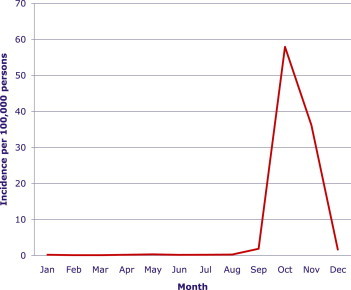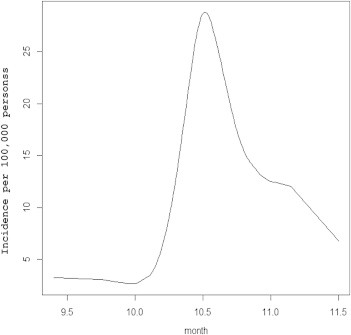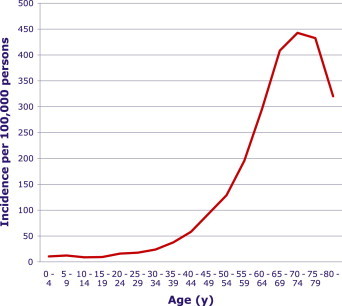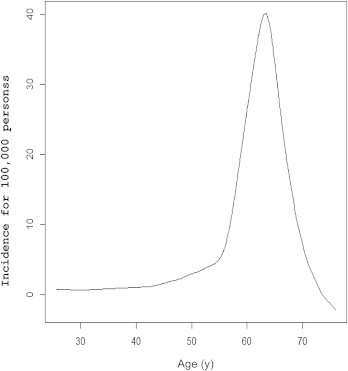Articles
- Page Path
- HOME > Osong Public Health Res Perspect > Volume 4(1); 2013 > Article
-
Original Article
Are There Spatial and Temporal Correlations in the Incidence Distribution of Scrub Typhus in Korea? - Maengseok Noha, Youngjo Leeb, Chaeshin Chuc, Jin Gwackc, Seung-Ki Younc, Sun Huhd
-
Osong Public Health and Research Perspectives 2013;4(1):39-44.
DOI: https://doi.org/10.1016/j.phrp.2013.01.002
Published online: February 28, 2013
aDepartment of Statistics, Pukyong National University, Busan, Korea.
bDepartment of Statistics, Seoul National University, Seoul, Korea.
cDivision of Epidemic Intelligence Service, Korea Centers for Disease Control and Prevention, Osong, Korea.
dDepartment of Parasitology and Institute of Medical Education, College of Medicine, Hallym University, Chuncheon, Korea.
- *Corresponding author. E-mail: shuh@hallym.ac.kr
• Received: December 21, 2012
Copyright ©2013, Korea Centers for Disease Control and Prevention
This is an Open Access article distributed under the terms of the Creative Commons Attribution Non-Commercial License (http://creativecommons.org/licenses/by-nc/3.0) which permits unrestricted non-commercial use, distribution, and reproduction in any medium, provided the original work is properly cited.
Figure & Data
References
Citations
Citations to this article as recorded by 

- Prevalence of chigger mites and Orientia tsutsugamushi strains in northern regions of Gangwon-do, Korea
Soojin Kim, In Yong Lee, Sezim Monoldorova, Jiro Kim, Jang Hoon Seo, Tai-Soon Yong, Bo Young Jeon
Parasites, Hosts and Diseases.2023; 61(3): 263. CrossRef - Urine Metabolite of Mice with Orientia tsutsugamushi Infection
Sangho Choi, Do-Hwan Ahn, Min-Gyu Yoo, Hye-Ja Lee, Seong Beom Cho, Hee-Bin Park, Sung Soon Kim, Hyuk Chu
The American Journal of Tropical Medicine and Hygi.2023; 108(2): 296. CrossRef - Spatiotemporal dynamics and environmental determinants of scrub typhus in Anhui Province, China, 2010–2020
Xianyu Wei, Junyu He, Wenwu Yin, Ricardo J. Soares Magalhaes, Yanding Wang, Yuanyong Xu, Liang Wen, Yehuan Sun, Wenyi Zhang, Hailong Sun
Scientific Reports.2023;[Epub] CrossRef - Epidemiological characteristics of cases with scrub typhus and their correlation with chigger mite occurrence (2019–2021): A focus on case occupation and activity locations
Se‐Jin Jeong, Jin‐Hwan Jeon, Kyung won Hwang
Entomological Research.2023; 53(7): 247. CrossRef - Epidemiological characteristics and spatiotemporal patterns of scrub typhus in Yunnan Province from 2006 to 2017
Pei-Ying Peng, Lei Xu, Gu-Xian Wang, Wen-Yuan He, Ting-Liang Yan, Xian-Guo Guo
Scientific Reports.2022;[Epub] CrossRef - Clinical and Laboratory Predictors associated with Complicated Scrub Typhus
Mi-Hee Kim, Si-Hyun Kim, Jung-Hyun Choi, Seong-Heon Wie
Infection & Chemotherapy.2019; 51(2): 161. CrossRef - Awareness and Work-Related Factors Associated with Scrub Typhus: A Case-Control Study from South Korea
Dong-Seob Kim, Dilaram Acharya, Kwan Lee, Seok-Ju Yoo, Ji-Hyuk Park, Hyun-Sul Lim
International Journal of Environmental Research an.2018; 15(6): 1143. CrossRef - Estimating the burden of scrub typhus: A systematic review
Ana Bonell, Yoel Lubell, Paul N. Newton, John A. Crump, Daniel H. Paris, Janet Foley
PLOS Neglected Tropical Diseases.2017; 11(9): e0005838. CrossRef - Spatiotemporal Dynamics of Scrub Typhus Transmission in Mainland China, 2006-2014
Yi-Cheng Wu, Quan Qian, Ricardo J. Soares Magalhaes, Zhi-Hai Han, Wen-Biao Hu, Ubydul Haque, Thomas A. Weppelmann, Yong Wang, Yun-Xi Liu, Xin-Lou Li, Hai-Long Sun, Yan-Song Sun, Archie C. A. Clements, Shen-Long Li, Wen-Yi Zhang, Mathieu Picardeau
PLOS Neglected Tropical Diseases.2016; 10(8): e0004875. CrossRef - Larval Chigger Mites Collected from Small Mammals in 3 Provinces, Korea
In-Yong Lee, Hyeon-Je Song, Yeon-Joo Choi, Sun-Hye Shin, Min-Kyung Choi, So-Hyun Kwon, E-Hyun Shin, Chan Park, Heung-Chul Kim, Terry A. Klein, Kyung-Hee Park, Won-Jong Jang
The Korean Journal of Parasitology.2014; 52(2): 225. CrossRef








 PubReader
PubReader Cite
Cite
